How Do Jumping Cactus Work? + Removal Guide

The world of succulents and cacti never ceases to amaze us. Among all the exotic plants that you can find in this category, one name certainly captures the attention: the jumping cholla cactus, or simply the jumping cactus.
This interesting cactus belongs to the cholla genus. This genus has about 35 species of cylindroid-jointed cacti. All members of this family are native to North and South America and the West Indies.
Chollas have different sizes (from a few inches to 10 feet). With small flowers, you can identify these jumping cacti by their glochidia, small bristles with backward-facing barbs in the areoles that jump and are not easy to remove from the skin.
But do jumping cholla really jump? How do jumping cactus work anyway? What does a jumping cactus look like? What should we do in case of the jumping cactus attack?! Can we grow it as a houseplant? Below, we will answer all these questions.
Getting to Know Jumping Cactus
Before discussing how does jumping cholla work, let us review the basic information about this fascinating plant.
Jumping cactus is a common name for Cylindropuntia fulgida (chain fruit cholla) and the Cylindropuntia bigelovii (teddy bear cholla), both belonging to the cholla genus. We will introduce these varieties later. In addition to jumping cholla, this plant is also known as:
- Hanging chain cholla
- Cholla brincadora
- Velas de coyote
The jumping cholla cactus is from Sonora and the Southwestern United States. However, you cannot find it in the Sierra Madre Occidental cordillera and Tiburon and Isla Ángel de la Guarda (east and northern California).
What Does a Jumping Cactus Look Like?
This tree-like plant features a low-branching trunk and can grow up to 13 feet. The jumping cactus stem is light green with small projections. The spines are the leaves, and there are 6 to 12 of them on an areole. The spines are about an inch and have a silvery-yellow color that turns into gray as the plant ages.
When the spines fall off older parts, you can see a brown-black bark that becomes rough and scaly over time, known as the plant’s wood.
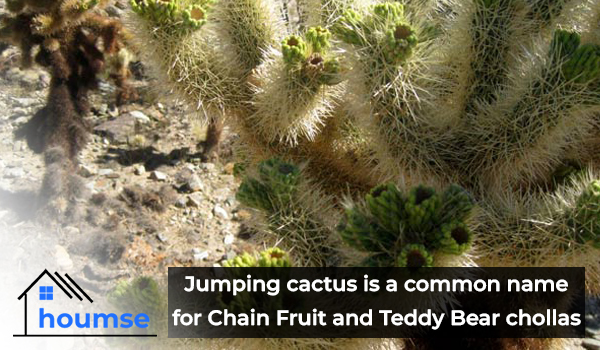
Jumping Cholla Cactus Uses
Knowing what does a jumping cactus look like and that jumping cactus attack is a real incident, one may imagine little use for this species. However, that is not true.
In their natural habitat, desert livestock eats jumping cacti. Its wood, resembling a hollow cylinder with holes, is used as fuel and other novelties. Cholla jumping cactus fruits are edible. You can the whole fruit by boiling it or only eat the inside when it is raw.
The buds are also edible. They are highly nutritious, low in calories, and benefit from high amounts of calcium and iron. You can harvest them in late April or early May. However, it is not easy to get something edible from this tricky plant.
And in the mid-summer, you can simply enjoy jumping cholla’s white-pink flowers that bloom at the joint tips and grow up to one inch.
What Animal Eats Cholla Cactus?
You probably already know that camels eat cacti more than other animals. But what animal eats cholla cactus? Jackrabbits, peccaries, deer, squirrels, iguanas, tortoises, birds, and beetles are the main animals that eat the jumping cacti’s fruit.
Other Jumping Cactus Facts
The ability of humping is not the only interesting thing about this plant.
- This cactus is one of the largest cacti in the desert (growing up to 15 feet) and can live for decades.
- A mature plant can attach to anything that comes close easily. The spines are not toxic but cause painful irritations.
- In a succulent collection, they are excellent complements to yucca, aloe, and agave.
- Its varieties have eye-catching star-shaped flowers with warm colors including red, pink, orange, and yellow-green.
How Do Jumping Cactus Work?
After realizing how does jumping cholla work, you may ask:
- “Are jumping cactus alive?” Of course.
- “Do jumping cacti really jump?” Kind of.
- “Why do jumping cactus jump?” To protect themselves and multiply.
Remember the glochidia? When the spine has ripened, these spiny segments easily break off when animals get close to it or during heavy storms. And regarding people, the slightest touch will cause small bits to hang on them. This is known as a jumping cactus attack.
This unique adaptation helps jumping cacti multiply in different locations. After detaching from the main plant, it will begin rooting when it hits the ground. If you look at the ground around a mature plant, you will find many fallen dead stems and young plants starting from them.
Now that you know how do jumping cactus work and why do jumping cactus jump, it may come in handy to know what to do if this cactus jumped on you.
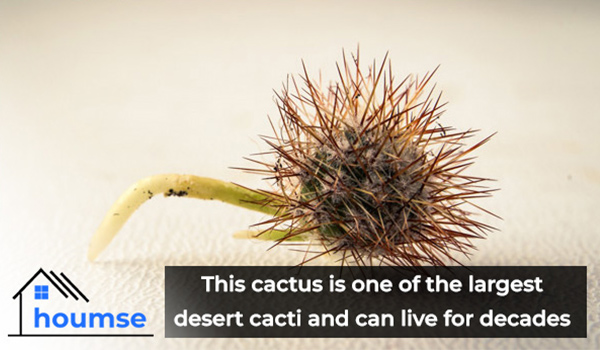
Jumping Cactus Removal
The different thing about getting pricked by this plant is that you are not simply dealing with a spine, but an entire circular pod. This makes the jumping cactus removal challenging and a little painful.
After a jumping cactus attack, grabbing the spines and struggling makes everything worse. So, whatever you do, do not pull it out. Because the pods have needles with microscopic thorns that act like a barbwire in the skin. These are jumping cactus removal methods in different cases:
Jumping Cactus Attack by Spines
First, use a pair of scissors or pliers to clip the spines attached to the stem and leave about half-inch of the spine in the skin. If handy tools are not available for jumping cholla removal, try bending over, stepping on the stem joint, and tugging your hand free. Keep in mind that this method may cause a bit more bleeding since you are pulling the spines away.
The next step for removing jumping cacti depends on the kind of spine. For larger, straight, and needle-like spines, try a pair of tweezers, which is going to be quite easy. However, barbed jumping cholla spears or hooked spines are more challenging.
Jumping cacti spines will often break when removed, leaving pieces lodged under the skin and making the area sensitive to the touch. You can use tweezers to excavate such fragments, but they can be translucent and hard to find. To avoid more damage, unless you can see the broken piece, it might not be worth doing it.
Tip: Try a warm bath with Epsom salt to relieve the pain from embedded spines.
Jumping Cactus Attack by Glochids
Remember the glochids while describing what does a jumping cactus look like and how do jumping cactus work? Removing them is a bit trickier. It is also easier to end up with dozens or more stuck in your skin!
In this case, you may want to soften the tiny barbs by running the attacked area under warm water and then scraping the bristles off with a knife. However, this method can leave the tips on your skin and bother you for a while.
Tiny tweezers (like the ones that come with a Swiss Army Knife) are ideal for plucking glochids. So, avoid using that larger tweezer in your bathrooms for grasping tiny prickles. For jumping cholla removal, a magnifying glass can help you as well. Some recommend using something sticky like duct tape to tug the barbs out of the skin too.
Tip: If removing all spines or barbs was not successful, do not panic. Most of the time, they disintegrate inside your body or be pushed out soon.
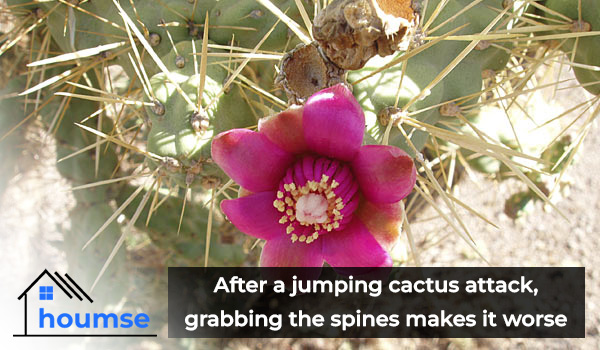
Cholla Jumping Cactus Varieties
Chain fruit cholla and teddy bear cholla also have joints that jump around and hold on to what has been close to them. They have their own characteristics as well.
Teddy Bear Jumping Cactus (Cylindropuntia bigelovii)
The teddy bear jumping cactus has jointed stems. They are 2 to 10 inches long and are usually hidden in a dense 7- to 10-inch-long array of spines. Its branches are called tubercles since they have raised areas and are not really cylindrical.
The flowers of this jumping cholla cactus have a greenish-yellow color and do not grow larger than 1.5 inches wide. These small flowers later turn into deciduous, fleshy fruits.
Chain Fruit Cholla (Cylindropuntia fulgida)
You can identify the chain fruit cholla with its cylindrical jointed stems that are about 8 to 10 feet tall. They have a light green color and some knotty ridges.
Their flowers have a similar size to the teddy bear jumping cactus, but they have a beautiful magenta flower. This type gets its name from the growth pattern of its fruits. The fruits appear persistently, and the aerosols produce even more fruits, creating a chain fruit.
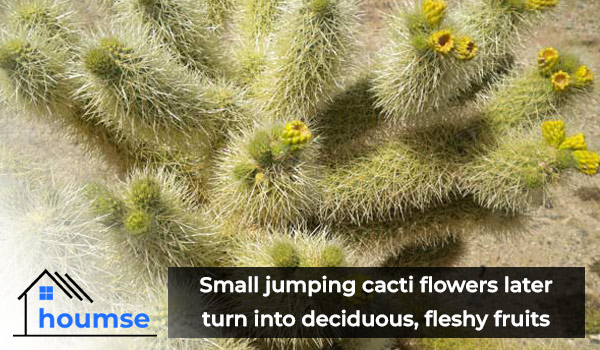
Propagating Jumping Cholla Cactus
Paying attention to a few things, you can propagate this plant successfully using seeds or cuttings. Seeds are the best choice if you prefer to get a pure species, but they are slow to germinate and grow. On the other hand, plucking stem offshoots out and growing them in individual pots guarantees a quicker result.
It is important to consider the temperatures and the season before propagation. Temperatures above 60° F are ideal and let the cholla jumping cactus root successfully. Also, make sure you get the cuttings from a healthy plant.
For propagating using cuttings, wear thick gloves and follow these steps:
- Disinfect a sharp knife and remove the stem offshoot in a slanted manner. This method prevents the parent plant from collecting water at the cut area. You can also simply snap the stem offshoot off from the joint with your hands.
- Optional: Dip the cutting base in a common rooting compound such as sulfur to improve the chances of rooting.
- Wait a few days until the base of the cutting is callused. This important step protects your young jumping cacti from common soil-borne diseases.
- When the cutting is callused, fill the chosen container (that has drainage holes) with rich and well-draining soil mix. Commercial versions will do just fine. You can prepare the mix yourself by mixing an equal amount of peat or compost and pumice or perlite as well.
- At least 3 inches of the cutting should be covered by the soil. Spray some water if the soil is too dry and place it in a bright location by the window or balcony.
After a few weeks, you should be able to see signs of rooting (like a growing tip).

Jumping Cactus Care
To grow this low-maintenance plant, you need to know its needs, which are:
Watering
This plant can handle drought periods very well but still has its own water requirements. You should water this cactus in moderation. Watering should be regular for the first few months as the jumping cholla cactus gets used to the new environment. After settling in, water it less often.
Always ensure that the top inch of the soil is dry before irrigation and adjust the frequency depending on the weather. For example, if you are in a hot region, watering should be more frequent compared to colder weather.
Remember that under-watering is better than over-watering, as the first does not cause root rots.
Light
During the first stages of jumping cholla cactus life, enough light is crucial. So, make sure to place it where it can get maximum sunlight, such as a south or southeast-facing window.
If such a location is not available, use grow lights for at least 10 to 14 hours a day. You can find these lights in any electronics store. This plant also needs some dark periods for developing.
Feeding
The jumping cactus can grow well in a suitable soil mix or even on barren lands. But when grown at home, it sure can use some fertilizer. Feeding provides a consistent flow of nutrients for your plant without compromising its survival.
Feed your cactus with fertilizer that is specifically made for cacti and other succulents on a regular basis (like during the watering routine). Water-soluble, low nitrogen fertilizers (5-10-10 or 10-10-10 but) are also applicable.
Too much fertilizer weakens your jumping cholla cactus. So don’t forget to dilute the NPK fertilizers to ¼ of their strength.
Transplanting
The jumping cactus grows quickly with the right care, and soon you will have to repot it. This way the root system will not crowd, and the plant can get some fresh and fertile soil.
When repotting, use the right type of container. If you are living in a hot area, use a plastic container so the soil moisture maintains for a longer time. If you have a tall variety, clay pots are the best choice. They absorb excess water and prevent root rot in case of over-watering.
For outdoor plants, you do not need transplanting. But if you need to completely move it to another place, see the next part to learn jumping cactus removal.
How To Remove Jumping Cactus from Its Pot
For jumping cactus removal from its pot, you will need protective gloves, a tarp, some newspaper, a pail, and a shower. After preparing the equipment, follow these steps:
- Cover the plant with a tarp and tuck it against its base to enclose its branches. If you are dealing with a big plant, wear protective gloves, fold layers of newspaper around the stems, and break them off until you are left with a more compact plant. Store the branches that you removed in a solid container.
- Dig the soil around the jumping cholla cactus’s base away. Insert the shovel around the base. When it reaches under the plant and the cactus moves, pry the whole plant up.
- When it is loose, place the pail over the tarped cactus. Lift with the shovel under the root base and flip the plant out, turning the pail upright again. Now you can safely carry it to another location or give it to someone else.
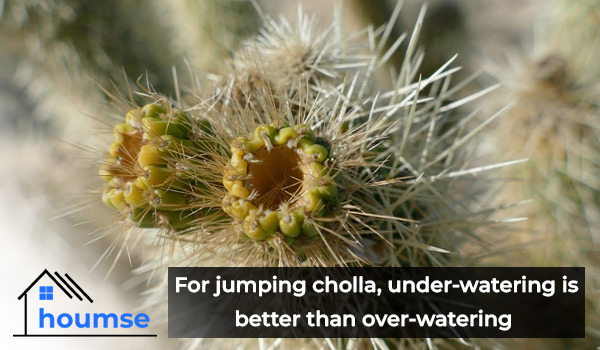
Jumping Cacti Pests and Diseases
This low-maintenance plant is resistant to various pests and diseases, but some can cause problems:
Cochineal Scale Insects
These insects suck the plant’s sap and create white and brown patches. In addition to the patches, you can easily notice them because of their sticky white appearance.
If growing outdoors, remove the insects using a garden hose. And if growing indoors, treat your jumping cactus with a mixture of water and alcohol. Apply it to the affected areas. They will be gone after a few days.
Cactus Longhorn Beetle
These one-inch beetles have a shiny black color and white patches on their antennae. They burrow into the plant’s stem and lay their eggs, leading to black rusty deposits on the stem. In stronger attacks to the root, the plant may even droop over and die.
To prevent these scenarios, you can simply handpick these beetles from the stem. If there are too many of them, chemical control is recommended.
Root Rot and Stem Rot
As mentioned, overwatering is the main cause of these diseases.
Final Thoughts
Jumping cholla cactus is an excellent and easy-to-grow plant for both indoors and outdoors. But if you have children or pets, outdoors is probably a better option due to its jumping tendency. When grown outdoors, you will not need to prune the offshoots to prevent overgrowing as well.
The right temperature, regular watering, full sunlight, and pest-free conditions are all that the cholla jumping cactus needs. It will thank you later by producing bright flowers and creating a lovely landscape.
- In this post:
- Getting to Know Jumping Cactus
- What Does a Jumping Cactus Look Like?
- Other Jumping Cactus Facts
- How Do Jumping Cactus Work?
- Jumping Cactus Removal
- Cholla Jumping Cactus Varieties
- Propagating Jumping Cholla Cactus
- Jumping Cactus Care
- Jumping Cacti Pests and Diseases



